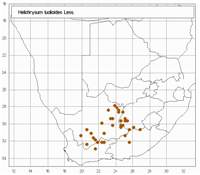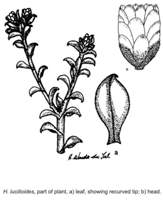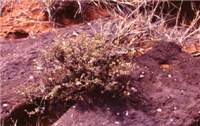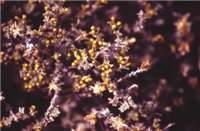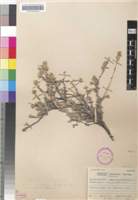Common names:
Bergkerriebos, Bergankerkaroo (A)
Diagnostic characters:
Straw-coloured bracts, often tinged reddishWoody plant with thick 'gnarled' baseLeaves often folded on the midribVery small compact flower heads
Description:
Dwarf, hard, gnarled, intricately branched shrub 500-600 mm high, or more lax with spreading branches, main stem 20-30 mm diam., twigs thinly tomentose, closely leafy. Leaves mostly 3-12 x 2-5 mm, thick, obovate, obtuse, tip recurved-mucronate, base narrowed, petiole-like in larger leaves, margins somewhat crisped-undulate, both surfaces thinly greyish-white woolly (but see note below). Heads homogamous, cylindric, 5-7 x 2-4 mm, 2 to several clustered at the branchlet tips, surrounded by leaves. Involucral bracts in 4 series, soon caducous, graded, imbricate, outer lightly webbed to 1 or 2 upper leaves, inner about equaling flowers, all subpellucid, pale yellow or straw-coloured, sometimes reddish below, glossy, oblong, obtuse, somewhat concave, not radiating, soon caducous. Receptacle scarcely honeycombed. Flowers 9-18. Achenes not seen, ovaries with myxogenic duplex hairs. Pappus bristles many, in more than one series, equaling corolla, scabrid, bases cohering strongly by patent cilia.
Flowering between September and May, but mainly in October.
Distribution:
Grows on rocky or stony hills or karroid plains. Widely distributed in the dry areas from the southern part of Namibia and the Richtersveld to northern Namaqualand east through Griqualand West to Kimberley district and the southern Free State as far east as Aliwal North degree square and south to Laingsburg district in the west, Willowmore and Cradock in the east.
Savanna, Grassland, Succulent Karoo and Nama Karoo Biomes.
Notes:
The bushes are often grazed and may send out long decumbent new shoots that are possibly a means of vegetative propagation.Herbarium specimens often show the hard woody base with few short new shoots.
Taxonomy:
Literature:
Helichrysum lucilioides Less., Syn. Comp. 290 (1832); DC., Prodr. 6: 191 (1838); Harv. in F.C. 3: 236 (1865); Moeser in Bot. Jb. 44: 297 (1910); Merxm., F.S.W.A. 139: 95 (1967).
Type:
Cape of Good Hope, Thunberg (sheet 19261, UPS, holo.).
Synonym(s):
Gnaphalium staehelinoides Thunb., Prodr. 150 (1800), Fl. Cap. 652 (1823), non Helichrysum staehelinoides Less. (1832). Type as above.
Leontonyx ramosissimum O. Hoffm. in Kuntze, Rev. Gen. 3,2: 162 (1898). Type: Cape, Cradock, 12 ii 1894, O. Kuntze (K; fragment PRE, mounted with Smith 5264).
Vouchers:
Burchell 1690 (K, PRE); Compton 6739 (NBG); Dinter 4133 (BOL; M; PRE; SAM); Leistner 1522 (M; PRE); Tyson 367 (BOL; SAM).
